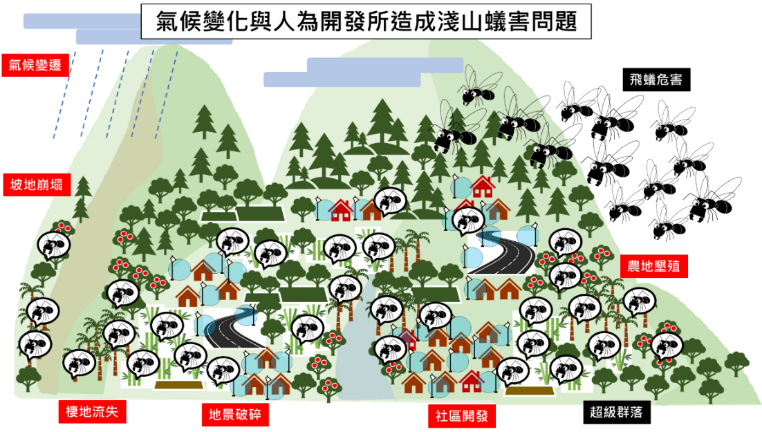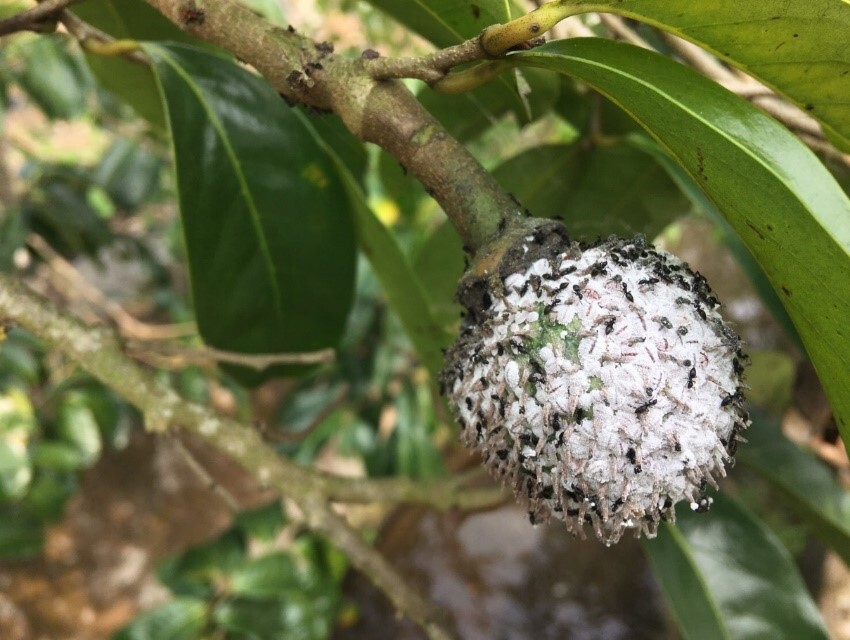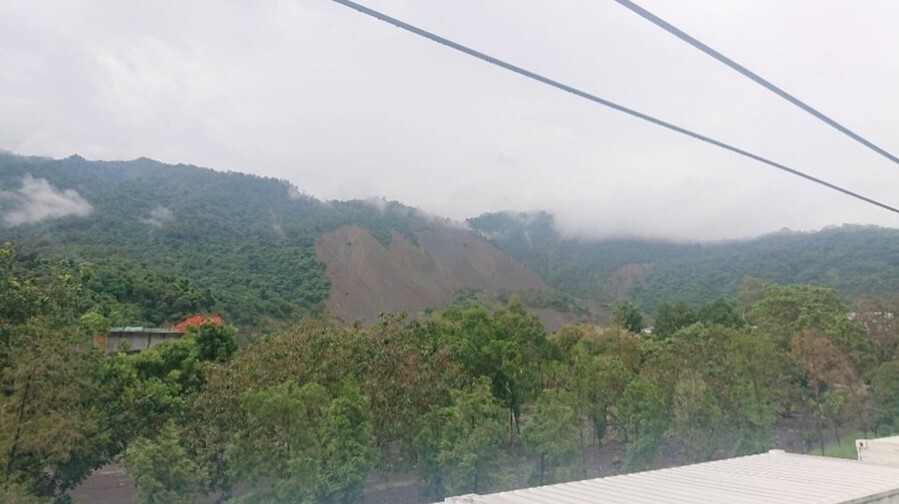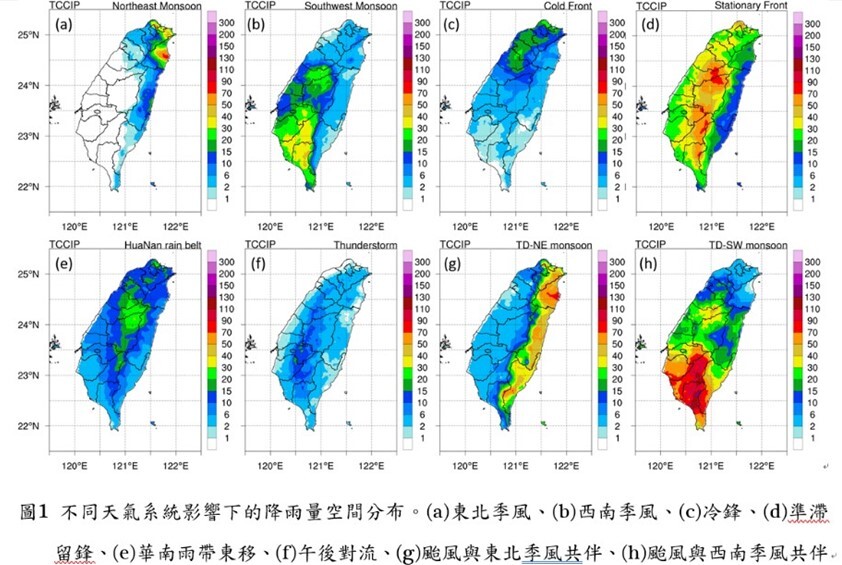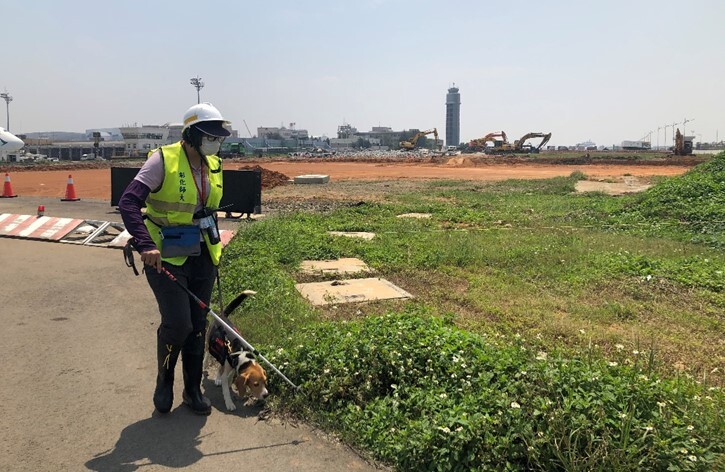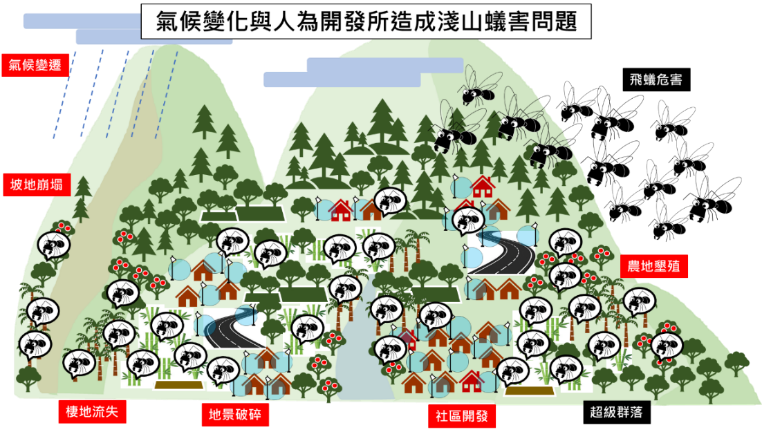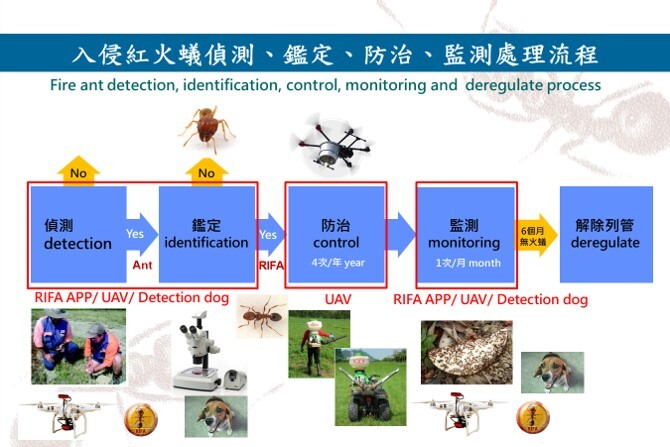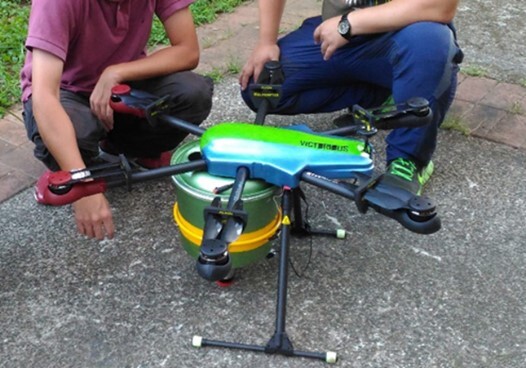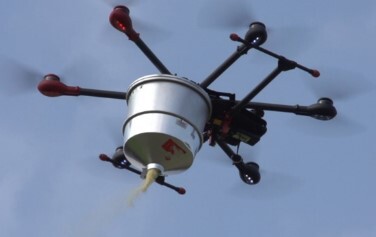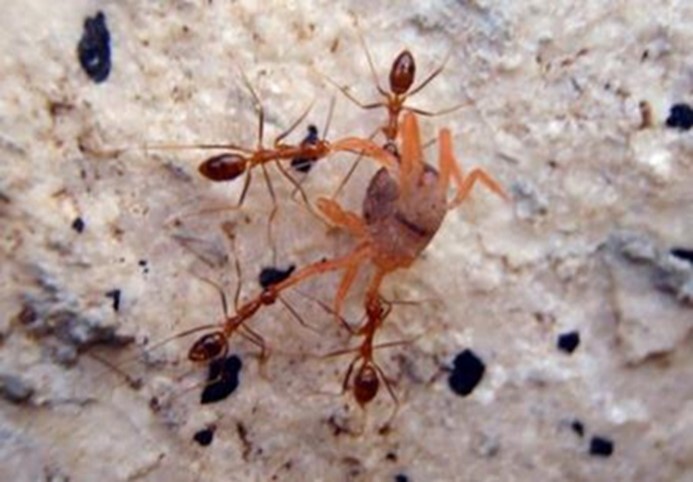SDG 13.3.2 Climate Action Plan, shared
1. Our faculty members implemented Ministry of Science and Technology projects to provide advice and assistance to local and regional governments on the future planning of agricultural production systems, disaster prevention, and water resource allocation, as shown in Table 1.
Table 1. Serial No., Principal Investigator, Project Title
|
No. |
Project leader |
Project name |
|
1 |
Professor Lin Chung-Chi |
Impacts of Climate Change on Lowland Ecology and Lowland Ant Problems Due to Community Changes: Discussion and Solutions (Annex 13.3.2A - Report of Outcomes) |
|
2 |
Professor Tu Jien-Yi |
Spatial distribution of rainfall hotspots influenced by different weather systems in Taiwan (Annex 13.3.2B - Report of Outcomes) |
Details of the project are provided below:
(1)The Ministry of Science and Technology’s project was led by NCUE Professor Lin Chung-Chi. The project title is: “Impacts of Climate Change on Lowland Ecology and Lowland Ant Problems Due to Community Changes: Discussion and Solutions”. Issues targeted by the project: given natural disasters due to climate change and development stress, lowland areas in Taiwan are ecologically fragile, with issues of landscape fragmentation, ecological barriers, and habitat loss. In recent years, the emerging problem of ant infestation has appeared in the lowland towns of central and southern Taiwan. Ants flood into houses like streams and flying ants invade houses like black fog. Such abnormal ecological phenomena are a warning of the gradual loss of health in Taiwan’s ecological system. The project covered multiple areas, delving into the causes behind the ant infestation affecting lowland residents and identifying the issues of landscape fragmentation, ecological loss, and development stress. Within the framework of slope ecosystem services, the research team investigated key biologic facies in the habitats, analysed landscape changes, established relevant indicators, and analysed environmental vulnerability and ecological potential. Given the mechanism of the impact of ant problems on village industries and tourism, a lowland agricultural production system with ecosystem service potential and human welfare benefits was proposed under the context of climate change.
(2)The team also examined the relationship between invasive species and habitat spatial changes caused by climate changes. The action guidelines for biological disaster adaptation under climate change could inform the local government’s decision-making process. (Figure 1)
|
|
|
Figure 1. Ant infestation in shallow mountains is attributed to climate change and human factors |
Climate change and warming caused the overgrowth of honey insects (Planococcus citri), worsening ant problems in lowland areas (Figure 2: Technomyrmex albipes and Planococcus citri).
|
|
|
Figure 2. Technomyrmex albipes and Planococcus citri |
The phenomena of natural landscape fragmentation, ecological loss, and habitat destruction caused by debris avalanches in Taiwan’s lowland areas due to extreme rainfall (Figure 3: collapsed slope in lowland areas).
|
|
|
Figure 3. collapsed slope in lowland areas |
(3)Prof. Jien-Yi Tu/National Science and Technology Council (NSTC) Project/Spatial distribution of rainfall hotspots in Taiwan under the influence of different weather systems (Figure 4). Project description: This research analyzes the impacts of different weather patterns on rainfall in Taiwan and finds that there is a significant interaction between large-scale circulation, weather systems, and topography. Different circulation patterns and moisture transport, in conjunction with topographical effects, result in variations in the distribution of rainfall hotspots. Moreover, the sources of moisture also vary widely. Some weather systems are primarily associated with near-surface moisture transport (e.g., afternoon convection), while others are more dominant below 850 hPa (e.g., the northeast monsoon), some concentrate in the 850-700 hPa layer (e.g., stationary fronts), or even higher in the 700-500 hPa layer (e.g., the eastward movement of the South China Rainband). These differences in characteristics also remind us that future analyses of different weather systems should pay special attention to the location of the main moisture transport layer. The research findings allow us to gain a deeper understanding of the relationship between rainfall hotspots and circulation, providing substantial assistance and contributions to future government disaster preparedness planning.
|
|
|
Figure 4. Spatial distribution of rainfall under the influence of different weather systems |
2. There are seven environmental education programmes at NCUE in collaboration with NGOs. Each is described in detail, below.
|
No. |
Programme |
|
1 |
Fangyuan Reengineering USR Seed Programme and Sprouting Programme for Engaging Fangyuan and Dacheng: Industrial and Environmental Sustainability for Changhua’s Twin Towns |
|
2 |
Taoyuan International Airport Corporation Programme/entrusted to plan, design, and implement control measures against fire ants |
|
3 |
The Ministry of Science and Technology’s project/Impacts of Climate Change on Lowland Ecology and Lowland Ant Problems Due to Community Changes: Discussion and Solutions |
|
4 |
The Ministry of Science and Technology’s project/Reshaping Global Control Efforts for Invasive Species: Positioning Taiwan as the Hub of Control, Prediction, and Education of Asiatic Red Fire Ants |
|
5 |
The Ministry of Science and Technology’s project/Development of Microbiological Control Technologies for Harmful Ants in Farmland |
|
6 |
The project of the Animal and Plant Health Inspection Agency, Ministry of Agriculture/Development of Core Technologies and Construction of a Safety Assessment Model for Industrial Chain Agricultural Spraying based on Unmanned Aerial Vehicles (UAV): Field Experiment of UAVs Used against Invasive Red Fire Ants and System Management of UAV Pesticide Spraying |
|
7 |
Programme for Kenting National Park/Investigation on the Invasion and Control Strategy of Yellow Termites in Kenting National Park |
(1)Fangyuan Reengineering USR Seed Programme and Sprouting Programme for Engaging Fangyuan and Dacheng: Industrial and Environmental Sustainability for Changhua’s Twin Towns in 2020-2022: included in the research project: cooperation with the Changhua Aquaculture Association to explore adaptive measures to climate change.
(2)Taoyuan International Airport Corporation Programme/entrusted to plan, design, and implement control measures against fire ants. (Figure 5)
|
|
|
Figure 5. The NCUE-Taoyuan International Airport fire ant control team searches for imported red fire ants at Taoyuan Airport with the assistance of a fire ant detection dog |
(3)The Ministry of Science and Technology’s project/Impact of Climate Change on Lowland Ecology and Lowland Ant Problems Due to Community Changes: Discussion and Solutions. (Figure 6)
|
|
|
Figure 6. The project delved into the causes behind the ant infestation affecting lowland Zhongxing New Village residents in central and southern Taiwan and identified the issues of landscape fragmentation, ecological loss, and development stress. Within the framework of slope ecosystem services (supply, adapt, culture, and support), the research team investigated key biologic facies in the habitats affected by ant damage, and analysed environmental vulnerability and ecological potential. A lowland agricultural production system with ecosystem service potential and human welfare benefits was proposed under the context of climate change |
(4)The Ministry of Science and Technology’s Project/Reshaping Global Control Efforts for Invasive Species: Positioning Taiwan as the Hub of Control, Prediction, and Education of the Asiatic Red Fire Ants. (Figure 7)
|
|
|
Figure 7. Data model analysis and establishment of an innovative platform for invasive red fire ants. The project made significant contributions to the ongoing scientific debate on the causes of global invasive imported red fire ants as well as control measures for the fire ants, the impact on agriculture and economy, and the scientific development of Taiwan |
(5)The Ministry of Science and Technology’s project/Development of Microbiological Control Technologies for Harmful Ants in Farmland. (Figure 8)
|
|
|
Figure 8. Development and application of microbial control for the growing problem of harmful ants in the agricultural environment. Especially in the development of sustainable agriculture and organic agriculture, this research focuses on the design, development, and application of microbial agents on crops to control harmful ants as well as the valuable development of its practical value and commercial potential |
(6)Project of the Animal and Plant Health Inspection Agency, Ministry of Agriculture/Development of Core Technologies and Construction of Safety Assessment Model for Industrial Chain Agricultural Spraying based on Unmanned Aerial Vehicles (UAV): Field Experiment of UAVs Used against Invasive Red Fire Ants and System Management of UAV Pesticide Spraying). (Figures 9-10)
|
|
|
|
Figure 9. Assist in establishing a standard practice for pesticide application against invasive imported red fire ants on large areas or special terrains using agricultural drones |
Figure 10. Assist in establishing a standard practice for pesticide application against invasive imported red fire ants on large areas or special terrains using agricultural drones |
(7)Programme for Kenting National Park/Investigation on the Invasion and Control Strategy of Yellow Termites in Kenting National Park. Assisted Kenting National Park to investigate the invasion status of Anoplolepis gracilipes, one of the most harmful invasive species in the world, in the land crab distribution concentration areas. This study is the first time that Anoplolepis gracilipes has been found to threaten land crab populations in East Asia. In addition to ant damage, land crabs also face threats from road killing, habitat destruction, and human harvesting. (Figure 11)
|
|
|
Figure 11. Anoplolepis gracilipes attack young crabs |

